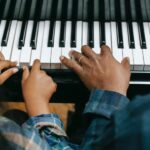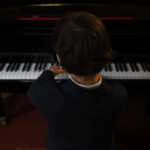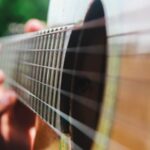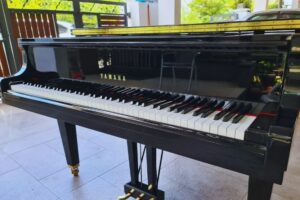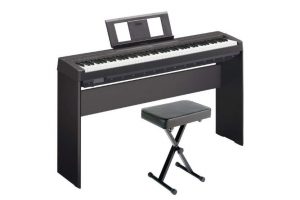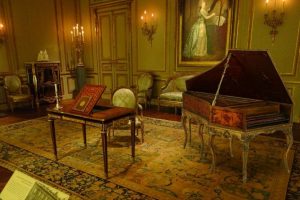Are you considering learning how to play the piano but don’t know how and where to start? Learning to play the piano is a rewarding endeavor, no matter how young or old you are. If you’re worried about expensive piano lessons, you can learn by yourself. How to learn piano by yourself?
To learn how to play piano by yourself, follow these 4 general steps:
- Learn the names of each key/note
- Learn the chords
- Learn correct fingering
- Learn how to read music
You should follow a consistent practice schedule, use the help of online resources, and learn songs you enjoy.
If you don’t already have a piano, I highly recommend getting a full-size 88-key digital keyboard, as well as an adjustable seat and dampening pedal.
Read on to learn more about how to learn to play piano by yourself, including tips for learning how to play it faster.
How to Learn Piano by Yourself
To learn piano by yourself, you need to first familiarize yourself with the keys, including the left black keys (flat keys), the right black keys (sharp keys), the middle keys, the high tones, and the bass. Then learn patterns, proper fingering, and how to read notes, using tutorials and available online resources.
There are 4 general steps to learn how to play piano. Below we will look at each step in detail.
1. Learn the Names of Each Key/Note
You have to know the names of all the piano keys, so you won’t have a hard time finding the right notes when playing the piano. But don’t worry, I have some tricks and tips for you that can help you with that.
Octaves
The piano patterns of the shapes are all the same. If you count the black keys, the pattern would be 2 and 3. You can consider 2-3 black keys as a set. Every 5 black keys are called a group. The first 2-3 or 5 keys set are called the first octave. Each set would be called an octave. For example, the third set of black keys would be called the third octave.
Keynotes
Focus on the two black keys which are together. On the left side of the two black keys, the white key under it is called a C note. Each octave has the same note names because the pattern is only repeating, so it would make sense that the note is repeating too. However, the sound is not the same, the name of the note is only the same, but the sound isn’t.
In every set/octave, there is a white C note. The next white keys to the C note are a D, E, F, and the G. The notes are like ABCs. The difference is that the notes start at C and end at G. If you are still not familiar with the notes, you can always label them while learning and then remove the labels later as you learn to memorize where they are located on the piano.
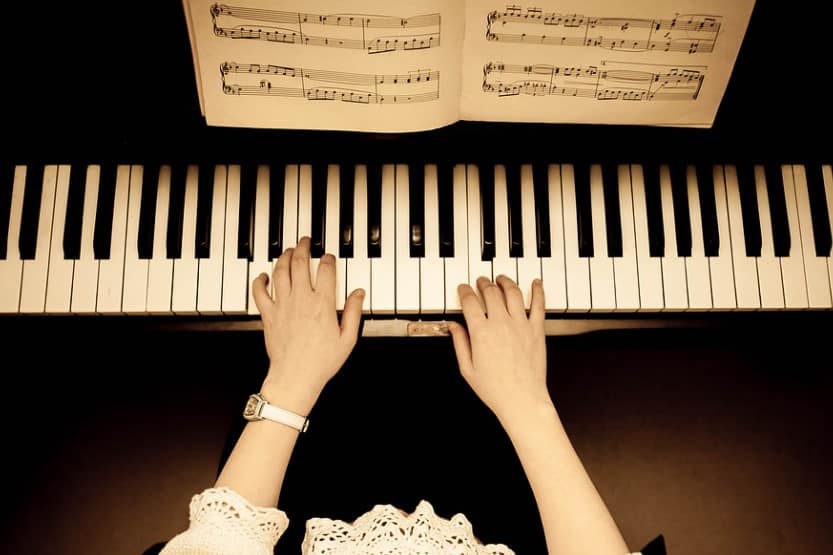
2. Learn the Chords
You should learn the chords of the piano for you to be able to play it. When learning the chords, you must first familiarize yourself with the scales, like the scale of C or D. Scales are like DoReMis. To learn the scale of C, you must start at C first, then proceed to play it until you finish with the DoReMi. When you want to form chords, you can use the count 1-5-8 for the major chords and 1-4-8 for minor chords.
3. Learn Correct Fingering
You should know the correct position of your fingers. To learn the proper fingering, you have to learn scales first. Learn the major scales first, followed by the minor scales. Number your left-hand fingers 1 to 5 from thumb to pinky. Likewise, number your right-hand fingers from 1 to 5 from right thumb to pinky.
A right-hand scale will use the following fingering: 1-2-3-1-2-3-4-5 and back down to 5-4-3-2-1-3-2-1. Ensure that your thumb plays the second 1 on the way up and the second 3 on the way down.
4. Learn How to Read Music
This is a crucial activity if you want to learn quickly. First, learn right-hand staff keys (treble clef) and the left-hand staff keys (bass clef). To remember the note placement easily on the treble clef, use the mnemonic: “Every Good Boy Deserves Food.”
As you practice the steps above, you will acquire the skills to play the piano and read music. We have discussed the steps on how to learn to play the piano by yourself. Let’s now proceed to some tips on learning quickly.
Tips for Learning Piano by Yourself Quickly
1. Be Optimistic
Being optimistic is the first step to learning anything quickly. When you have a positive frame of mind, you will perceive your failures as challenges and will strive harder to achieve your goals. You will also feel motivated to stay diligent when learning, and the process becomes an adventure for you.
This attitude will facilitate knowledge transfer, comprehension, and accumulation. It will help you to learn the piano faster.
2. Practice Regularly
Constant practice will make you learn swiftly. Playing the piano is a skill that you can acquire with regular practice. You can practice daily for one to two hours or more. This would depend on your learning style and pace.
Don’t force yourself to play when you are not in the mood. However, you must establish goals so that you will know your target goals every week or every month. Setting goals will keep you paced while you learn optimally.
3. Choose One Musical Piece to Play
After you have learned the basics, you can choose one of your favorite songs and turn it into your masterpiece. Practice this song until you have perfected its delivery.
Nevertheless, you can also practice playing other songs as well. The more musical pieces you have mastered, the more you will advance in your learning journey.
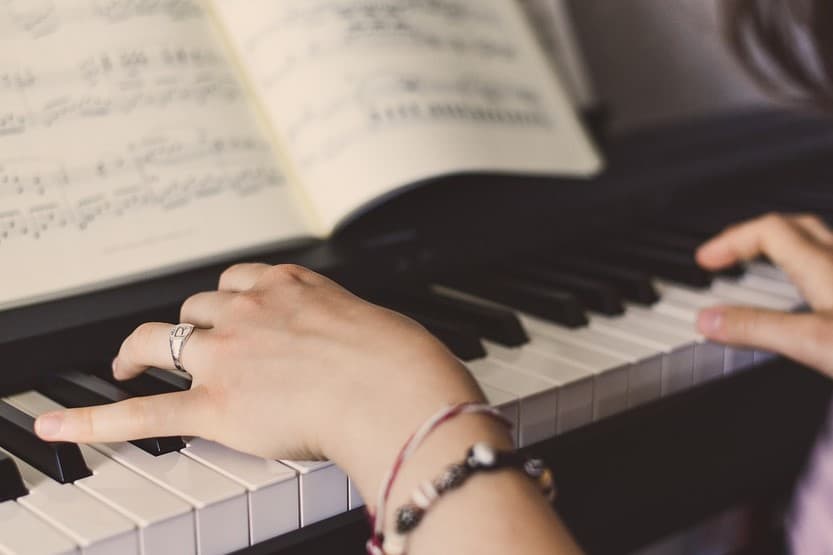
4. Take Advantage of Online Programs and Apps
There are online programs that will help you learn to play piano by yourself. You could use the free tutorial videos on YouTube and other music sites. Two excellent programs for learning the piano quickly are PianoforAll and Rocket Piano.
How to learn piano by yourself? To learn how to play piano by yourself at home, follow these 4 steps:
- Learn the names of each key/note
- Learn the chords
- Learn correct fingering
- Learn how to read music
It helps to have a good piano or digital keyboard when learning how to play the piano by yourself. Next, let’s look at tips for buying a piano for beginners.
Buying a Piano for Beginners
If you’re serious about learning how to play the piano, you must own one. Even if you take piano lessons, you will need a piano for practicing. You do not need a big, expensive acoustic piano to learn by yourself. You are better off having a digital keyboard.
There are 61-key keyboards and regular-size 88-key keyboards. I highly recommend getting an 88-key keyboard as you progress. You will want to play on a full-size piano. 61-key pianos are too limited.
The Alesis Virtue 88-Key Beginner Digital Piano is an excellent bundle pack for learning to play piano by yourself. It has everything you need to learn and grow into a better piano player for a great price.
Click here to see this piano on Amazon.
Acoustic vs Digital Piano
A piano or an acoustic piano (as others may call it) is an old-school musical instrument. It has hammers and steel strings that are enclosed by a wooden exterior. When you press the keys (which are connected to the hammer), the hammer moves and strikes the strings, causing them to vibrate to produce a sound.
You have to maintain an acoustic piano; you have to tune it if the piano has not been used for a long time or when it has been moved.
On the other hand, a keyboard piano or digital piano is like an acoustic piano, but the only difference is it runs by electricity. It’s a type of electric keyboard instrument designed to be an alternative to the acoustic piano.
Both pianos sound the same, but that depends on what type of digital piano you have. The more expensive digital pianos would sound as good as acoustic pianos, but the cheaper ones may sound shallow.
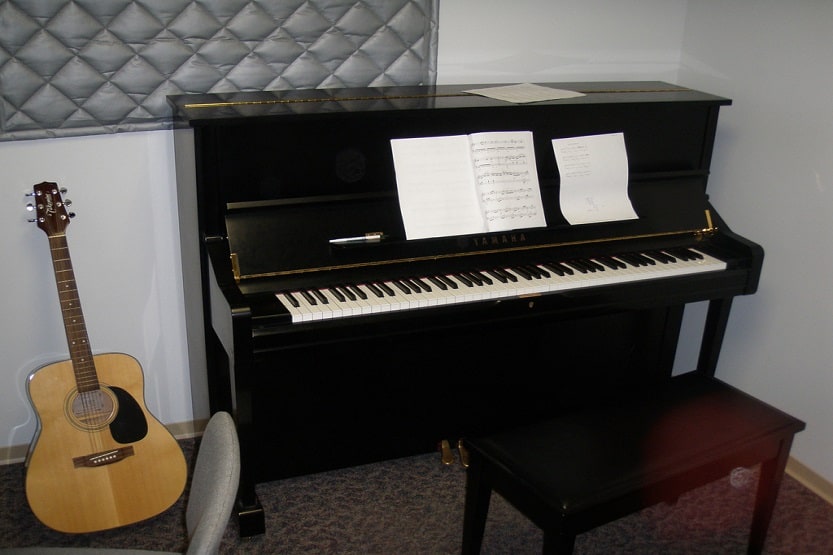
What to Consider When Buying a Piano
1. Budget
If you want to buy a piano, one of the things that you have to consider is your budget. It all comes down to how much money you’re willing to spend. Buying a piano can be pricey and can cost you a lot. That’s why you should set a budget, canvas, and look for a piano that is within your budget limit.
2. Commitment
The second thing to consider is your commitment to playing or learning the piano. Yes, this can have a huge impact on what kind of piano you should buy. This is because it can determine how many keys or notes your piano should have or what kind of perks your piano should offer.
3. Touch-sensitive Keys
If you get a digital keyboard, you should get one with touch-sensitive keys. When you press the keyboard piano, the sound should reflect how strong or weak you have pressed it. For example, when you press the keyboard softly, the sound would be low in quality. When you press the keys hard, the sound will be louder.
It isn’t worth the money at all to get a digital keyboard without touch-sensitive keys. One of the most important parts of playing piano is controlling the volume with how soft or hard you press the keys. So only choose a touch-sensitive keyboard.
4. Weighted Keys Are Better than Semi-weighted Keys
When buying a digital piano, there are pianos with weighted keys or semi-weighted keys. The weighted keys feel closer to the keys on an acoustic piano and hold their sound longer. Semi-weighted keys are suitable for beginners, in my opinion.
The Alesis keyboard I mentioned earlier is semi-weighted, not fully weighted. If you want a fully weighted digital keyboard, the price is higher but might be worth it for the higher quality sound.
A great digital keyboard with fully weighted keys is the Yamaha P45, 88-Key Weighted Action Digital Piano.
Click here to see this piano on Amazon.
Conclusion – How to Learn to Play Piano by Yourself
To learn how to play piano by yourself, follow these 4 general steps:
- Learn the names of each key/note
- Learn the chords
- Learn correct fingering
- Learn how to read music
Learning to play the piano by yourself can be intimidating. But it is easy if you break the steps into sections. First, you must have a good piano and other necessary materials for you to learn correctly.
Familiarize yourself with the piano parts. Learn the basic keys, such as the left black keys (flat keys), the right black keys (sharp keys), the middle keys, the high tones, and the bass. Then learn patterns, scales, proper fingering, and how to read notes.
You could use tutorials and available online resources to facilitate your learning process. There are thousands of videos, lessons, and websites offering free and paid materials. There is no reason for you not to learn how to play the piano by yourself. With grit, determination, and a positive mindset, you will be playing songs on the piano without needing expensive lessons.
Related reading:
How Hard Is It to Learn Piano?
Is Piano Easy to Learn? Plus How to Learn Fast
Best Way to Learn Piano [12 Tips for Learning How to Play Piano]






